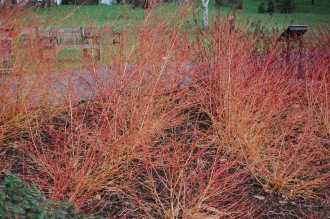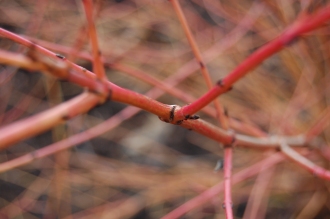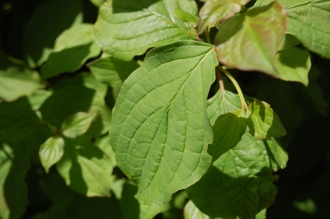Position: Full sun
Flowering period: Summer
Soil: Moist soil
Eventual Height: 3m (1m when stooled)
Eventual Spread: 3m (0.8m when stooled)
Hardiness: 4a, 4b, 5a, 5b, 6a, 6b, 7a, 7b, 8a, 8b, 9a
Family: Cornaceae
Cornus sanguinea ‘Midwinter Fire’ is a robust, deciduous shrub. The leaves of the plant are opposite, up to 8cm long and 4cm broad, with an ovate to oblong shape and an entire margin. They are green above and slightly paler below and turn orange/ yellow in autumn. The branches are upright. The juvenile branches of this plant are orange becoming red towards the tips. The flowers of the plant are borne in dense flat cymes, they are small, up to 1cm in diameter, with creamy white petals. The fruit of the plant is a black globose berry, up to 8mm in diameter containing a single seed. This plant may spread by stolons.
Cornus sanguinea ‘Midwinter Fire’, commonly known as Common Dogwood Midwinter Fire. The species, Cornus sanguinea, is native to most of Europe and western Asia, including some parts of the UK. C. sanguinea ‘Midwinter Fire’ was discovered in a German garden by H. Venhorst in about 1980, it was named ‘Midwinter Fire’ in 1990.
The etymological root of the binomial Cornus is from the Latin cornum meaning ‘horn’ due to its dense properties. Sanguinea is from the Latin meaning ‘blood red’, referring to the colour of the plant.
The landscape architect may find Cornus sanguinea ‘Midwinter Fire’ useful when planting en mass, providing autumn leaf colour and a fantastic display of stem colour during the winter months.
Ecologically, Cornus sanguinea ‘Midwinter Fire’ berries are eaten by some mammals and many birds. The leaves provide food for some moths and caterpillars.
Cornus sanguinea ‘Midwinter Fire’ prefers moist, fertile, well-drained soils. It tolerates most pH of soil.
Cornus sanguinea ‘Midwinter Fire’, if planted for its winter stem colour, will need to be stooled in early spring, before the spring growth starts.








If I plant this on the East side of my house with some Southern exposure for about 6 hours will the color be good in the winter?
The stems will always provide good winter colour. The more sun this plant receives the healthier it will be, the more vigorous its growth and the more spectacular the winter display. 6 hours of morning sun should be adequate for healthy growth. Good luck.